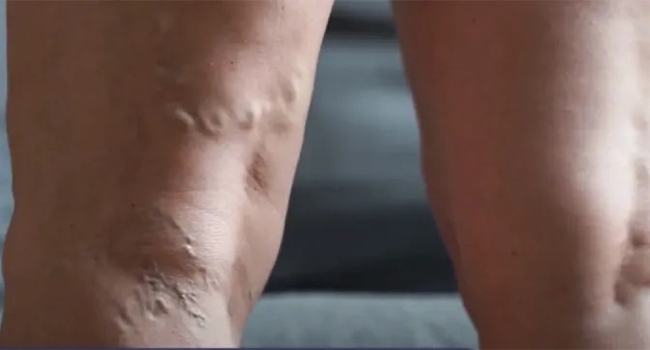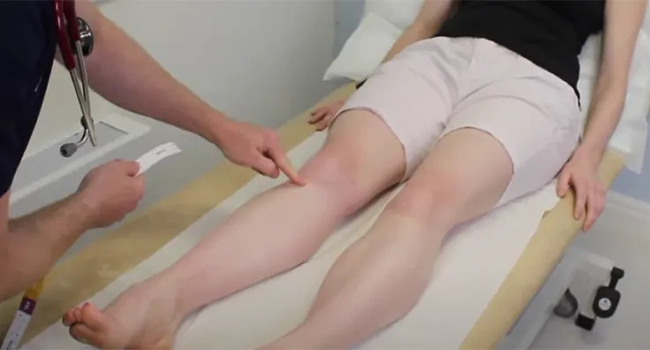Blood clots can form in your legs, arms, and groin veins. There’s a chance they’ll break loose and travel to other parts of your body, including your lungs, which can be life-threatening. Blood clots can also cause complications and negatively impact your health. You may experience painful skin ulcers on your leg.
The blood can get blocked by blood clots in the legs, causing swelling behind the clot, and the exact spot where the blood clot forms may swell up. Vein clots cause pain and swelling (often in the legs, cyclists’ favorite body part). A more dangerous possibility is that a piece of this clot can embolize.
This blog post helps you understand why and how a blood clot can cause swelling in the leg during cycling, what symptoms to look out for, and how to prevent and manage this condition. So, gear up to dive deep into the science behind those pedals and discover how to keep those legs healthy and safe.
Can a Blood Clot Cause Swelling? 7 Signs Cyclists Miss
Cycling can cause leg swelling from a blood clot. This condition, known as Deep Vein Thrombosis, happens in deep veins in the legs. When cycling, several factors can contribute to the development or exacerbation of DVT.
Symptoms Of A Blood Clot In The Leg And Buttocks

Those are potential symptoms of blood clots in your leg, often called deep vein thrombosis (DVT). Here’s a breakdown of each:
- Swelling: One of the most common symptoms is swelling in the affected leg. Mild to severe swelling may affect the entire leg or just a portion.
- Pain or cramping: People with a DVT often experience pain or cramping, typically in the calf or thigh. Symptoms can include dull ache, sharp pain, or both sensations and worsen when standing or walking.
- Pitting edema: Pressing on the swollen area may leave a visible indentation, known as pitting edema. This occurs because excess fluid has accumulated in the tissues.
- Discolored skin: The skin over the affected area may appear red or discolored and feel warm.
- Warmth: The affected leg may feel warmer than the unaffected one because of inflammation and increased blood flow.
- Varicose Vein Changes: A varicose vein that bulges out and does not flatten when you lie flat or raise your leg can be a warning sign of a deep vein thrombosis.
Reasons for Swelling Due to Blood Clots
- Inherited (genetic) conditions: Your genetic makeup could predispose you to blood clots, increasing the risk of swelling.
- Cancer and its treatments: Chemotherapy can exacerbate clotting risks, leading to swelling in affected areas.
- History of deep vein thrombosis (DVT): Past instances of DVT in yourself or family members can heighten the likelihood of swelling because of clots.
- Limited blood flow in deep veins: Immobilization from injury, surgery, or other factors can restrict blood flow, contributing to swelling.
- Prolonged immobility: Extended periods of sitting during travel or post-surgery immobility can lead to clot formation and subsequent swelling.
Additional Factors Contributing to Blood Clots and Swelling
- Advanced age: Individuals over 40 face an increased risk of DVT-related swelling.
- Overweight/obesity: Excess weight can strain circulation, making blood clots more likely.
- Autoimmune diseases: Conditions like lupus or inflammatory bowel disease can elevate clotting risks and swelling.
- Tobacco use: Smoking and tobacco products can impact circulation, potentially leading to blood clots and swelling.
- Contraceptive use: Birth control pills or hormone therapy can influence clot formation, contributing to swelling.
- Medical devices: Central venous catheters or pacemakers may increase the chance of blood clots and subsequent swelling.
- COVID-19: The virus has been linked to a higher risk of blood clotting issues and associated swelling.
Other Risk Factors for Blood Clots and Swelling
- Recent surgery: Post-operative periods pose an elevated risk of clot formation and swelling Advanced age: Individuals over 65 are more susceptible to blood clots and associated swelling.
- Hormonal birth control: Usage of contraceptives can affect clotting factors, potentially leading to swelling.
- Cancer treatment or history: Patients undergoing cancer treatment or with a history of cancer are at higher risk for blood clots.
- Traumatic injuries: Broken hip, pelvis, or leg injuries can trigger clotting and subsequent swelling.
- Prolonged immobility: Extended sitting or bed rest periods can contribute to blood clot development and resultant swelling.
- Previous clotting events: Individuals with past blood clot incidents or a family history of clots are at a higher risk of swelling because of clots.
- Sports activities: The risk factors for deep vein thrombosis (DVT) are generally the same for all persons, whether they are athletes or not. For instance, leg injuries sustained during sports activities, such as getting kicked or tackled, or even experiencing a minor trauma, like being hit in the leg with a hockey puck or ball, can lead to the development of DVT.
- The pinched nerve: The pinched nerve causes numbness or decreased sensation in the area it supplies. A sharp, aching, or burning pain may radiate outward.
5 Effective Tips for Preventing Blood Clots and Leg Swelling

Blood clots are a serious medical concern that can lead to various health complications, including swelling in the legs. Whether you’re at risk because of genetics, lifestyle factors, or a sedentary job, taking proactive steps to prevent blood clots is crucial for your overall well-being. Here are some simple yet effective tips to reduce blood clot risk and ease leg swelling.
Keep Moving
One of the most effective ways to prevent blood clots and reduce leg swelling is to keep your legs in motion. Sitting and standing for long periods can increase clots’ likelihood of forming as blood pools in the legs.
Make it a habit to move your legs regularly, especially if you’re sedentary or a desk job. Simple exercises like walking, stretching, or taking short standing breaks can promote healthy circulation and prevent blood clots from forming.
Say No to Smoking
If you’re a smoker, quitting is one of the best things you can do for your vascular health. A smoker’s blood vessels are damaged by smoking, increasing blood clot risk, among other serious health issues.
The chemicals in cigarettes can lead to inflammation and narrowing of the blood vessels, allowing blood clots to form. Kicking the habit reduces your blood clot risk and improves cardiovascular health.
Heel Raises
Engaging in simple exercises that promote blood flow can help prevent blood clots and alleviate leg swelling. One such exercise is heel raises. Sit or stand flat on the floor, then slowly raise and lower your heels while keeping your toes on the floor.
This movement helps activate the calf muscles, crucial in pumping blood back to the heart. Perform heel raises several times daily to keep blood circulating efficiently in your legs.
Toe Raises
Toe raises are another beneficial exercise for preventing blood clots and reducing leg swelling. As your heel raises, you sit or stand flat on the floor, then move your toes while keeping your heels on the floor.
This movement helps engage the muscles in the front of your legs, promoting circulation and preventing blood from pooling in the lower extremities. Incorporate toe raises into your daily routine to keep your legs healthy and avoid clot formation.
Leg Muscle Contractions
Another simple yet effective way to prevent blood clots is to tighten and release your leg muscles regularly. Every time you’re at your desk, watching TV, or lying in bed, take a few moments to contract and relax the muscles in your calves, thighs, and buttocks.
This action helps stimulate blood flow and prevents stagnation, reducing the risk of clot formation. Aim to perform leg muscle contractions several times daily to keep your circulation in check and protect against blood clots.
If cycling exacerbates swelling caused by blood clots (deep vein thrombosis or DVT), it’s essential to prioritize both treatment and safety. Here’s a multifaceted approach.
Medical Intervention
If a blood clot is suspected, treatment may include anticoagulant medications (blood thinners) to prevent the clot from growing or breaking loose and causing complications like a pulmonary embolism.
Your healthcare provider may recommend compression stockings to reduce swelling and improve blood circulation in the affected leg.
Rest and Elevation
Avoid activities that exacerbate swelling, including prolonged cycling. Resting with the affected leg elevated above heart level can help reduce swelling by aiding fluid drainage.
Physical Activity Modification
Temporarily refrain from cycling until the swelling and clot are under control. Engage in low-impact exercises recommended by your healthcare provider, such as walking or swimming, to promote circulation without aggravating the clot.
Pain Management
Ibuprofen and acetaminophen alleviate discomfort associated with swelling. However, consult your doctor before taking any medications, especially if you’re already on blood thinners.
Hydration and Nutrition

Stay well-hydrated and maintain a balanced diet of fruits, vegetables, and lean proteins. Proper hydration and nutrition support overall vascular health and can aid in the body’s healing process.
Follow-Up Care
Keep all follow-ups as scheduled. They will monitor your condition, adjust treatment as necessary, and provide guidance on when it’s safe to resume cycling and other physical activities.
Preventive Measures
Once the acute phase has passed, consider measures to prevent future blood clots, such as regular exercise, avoiding prolonged periods of immobility, and following any prescribed medications or lifestyle changes.
Conclusion
In an active community like ours, we ensure we keep our bodies in the best possible shape. Learning about health conditions such as DVTs and their potential impact on our lifestyles helps us become more attentive to symptoms. It encourages us to take proactive measures to maintain our health.
Whether it’s through adopting healthy habits, staying active, quitting smoking, or simply being mindful of prolonged periods of immobility, we can minimize the risks connected with blood clots and swelling. Remember, your safety and health are paramount, even as we chase the thrill of the ride. So, here’s to safer and healthier cycling adventures.
FAQs
Is there any indication that there may be a blood clot in the leg?
- Wise Choices.
- Leg swelling or swelling along a vein.
- The leg may feel tender or painful only when standing or walking.
- It feels warmer on a leg that’s swollen or painful.
- Red or discolored skin on the leg.
- Unexplained shortness of breath.
- Pain with deep breathing.
- Coughing up blood.
How Long Does Blood Clot Swelling Last?
It is estimated that half of the patients with a DVT in their legs experience intermittent leg pain and swelling, which may last for months or even years.
Can Cycling Cause Blood Clots?
Cycling typically reduces the chances of developing deep vein thrombosis, a blood clot in the veins, especially in the legs. There is no significant evidence linking cycling to an increased risk of DVT. However, staying hydrated and taking breaks to stretch during long rides are essential precautions to maintain overall vascular health.
Can I Cycle With A Dvt?
Cycling can be considered if you have deep vein thrombosis (DVT). Listen to your body and start slow. Don’t do strenuous exercise for the first two weeks after recovering.

![A blood clot may cause swelling in the leg during cycling 4 factors and 5 tips for prevention [6 treatments]](https://cacyclinghub.com/wp-content/uploads/2024/05/Can-A-Blood-Clot-Cause-Swelling-In-The-Leg-During-Cycling-1.jpg)
